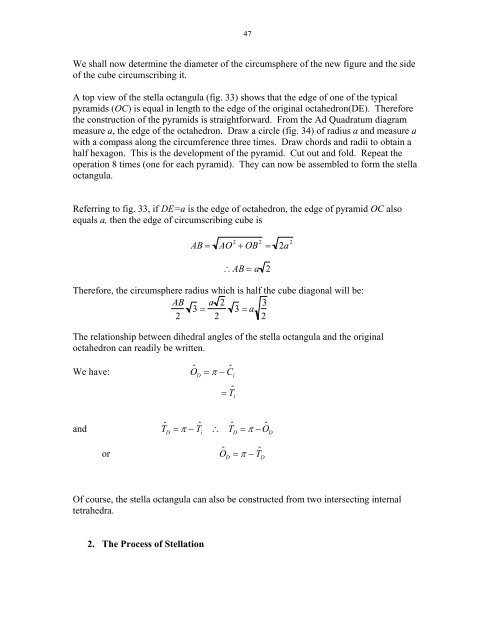Ad Quadratum Construction and Study of the Regular Polyhedra
Ad Quadratum Construction and Study of the Regular Polyhedra
Ad Quadratum Construction and Study of the Regular Polyhedra
You also want an ePaper? Increase the reach of your titles
YUMPU automatically turns print PDFs into web optimized ePapers that Google loves.
47<br />
We shall now determine <strong>the</strong> diameter <strong>of</strong> <strong>the</strong> circumsphere <strong>of</strong> <strong>the</strong> new figure <strong>and</strong> <strong>the</strong> side<br />
<strong>of</strong> <strong>the</strong> cube circumscribing it.<br />
A top view <strong>of</strong> <strong>the</strong> stella octangula (fig. 33) shows that <strong>the</strong> edge <strong>of</strong> one <strong>of</strong> <strong>the</strong> typical<br />
pyramids (OC) is equal in length to <strong>the</strong> edge <strong>of</strong> <strong>the</strong> original octahedron(DE). Therefore<br />
<strong>the</strong> construction <strong>of</strong> <strong>the</strong> pyramids is straightforward. From <strong>the</strong> <strong>Ad</strong> <strong>Quadratum</strong> diagram<br />
measure a, <strong>the</strong> edge <strong>of</strong> <strong>the</strong> octahedron. Draw a circle (fig. 34) <strong>of</strong> radius a <strong>and</strong> measure a<br />
with a compass along <strong>the</strong> circumference three times. Draw chords <strong>and</strong> radii to obtain a<br />
half hexagon. This is <strong>the</strong> development <strong>of</strong> <strong>the</strong> pyramid. Cut out <strong>and</strong> fold. Repeat <strong>the</strong><br />
operation 8 times (one for each pyramid). They can now be assembled to form <strong>the</strong> stella<br />
octangula.<br />
Referring to fig. 33, if DE=a is <strong>the</strong> edge <strong>of</strong> octahedron, <strong>the</strong> edge <strong>of</strong> pyramid OC also<br />
equals a, <strong>the</strong>n <strong>the</strong> edge <strong>of</strong> circumscribing cube is<br />
AB AO 2 OB 2 2a 2<br />
AB a 2<br />
Therefore, <strong>the</strong> circumsphere radius which is half <strong>the</strong> cube diagonal will be:<br />
AB<br />
2<br />
3 <br />
a 2<br />
2<br />
3 a 3<br />
2<br />
The relationship between dihedral angles <strong>of</strong> <strong>the</strong> stella octangula <strong>and</strong> <strong>the</strong> original<br />
octahedron can readily be written.<br />
We have:<br />
O ˆ<br />
D ˆ C i<br />
<strong>and</strong> ˆ<br />
T D ˆ<br />
T i ˆ<br />
T D ˆ<br />
O D<br />
or ˆ<br />
O D ˆ<br />
T D<br />
<br />
ˆ<br />
T i<br />
Of course, <strong>the</strong> stella octangula can also be constructed from two intersecting internal<br />
tetrahedra.<br />
2. The Process <strong>of</strong> Stellation




